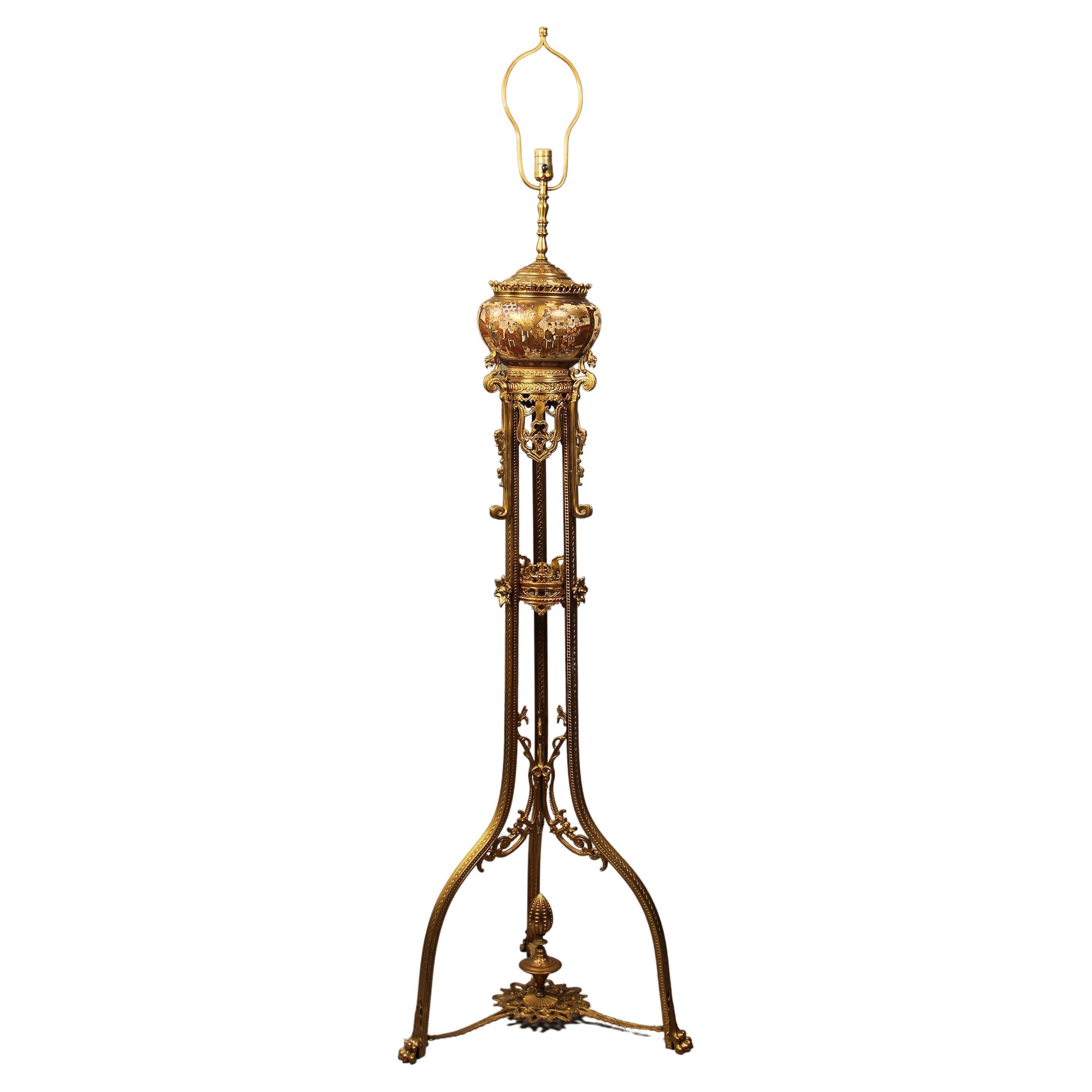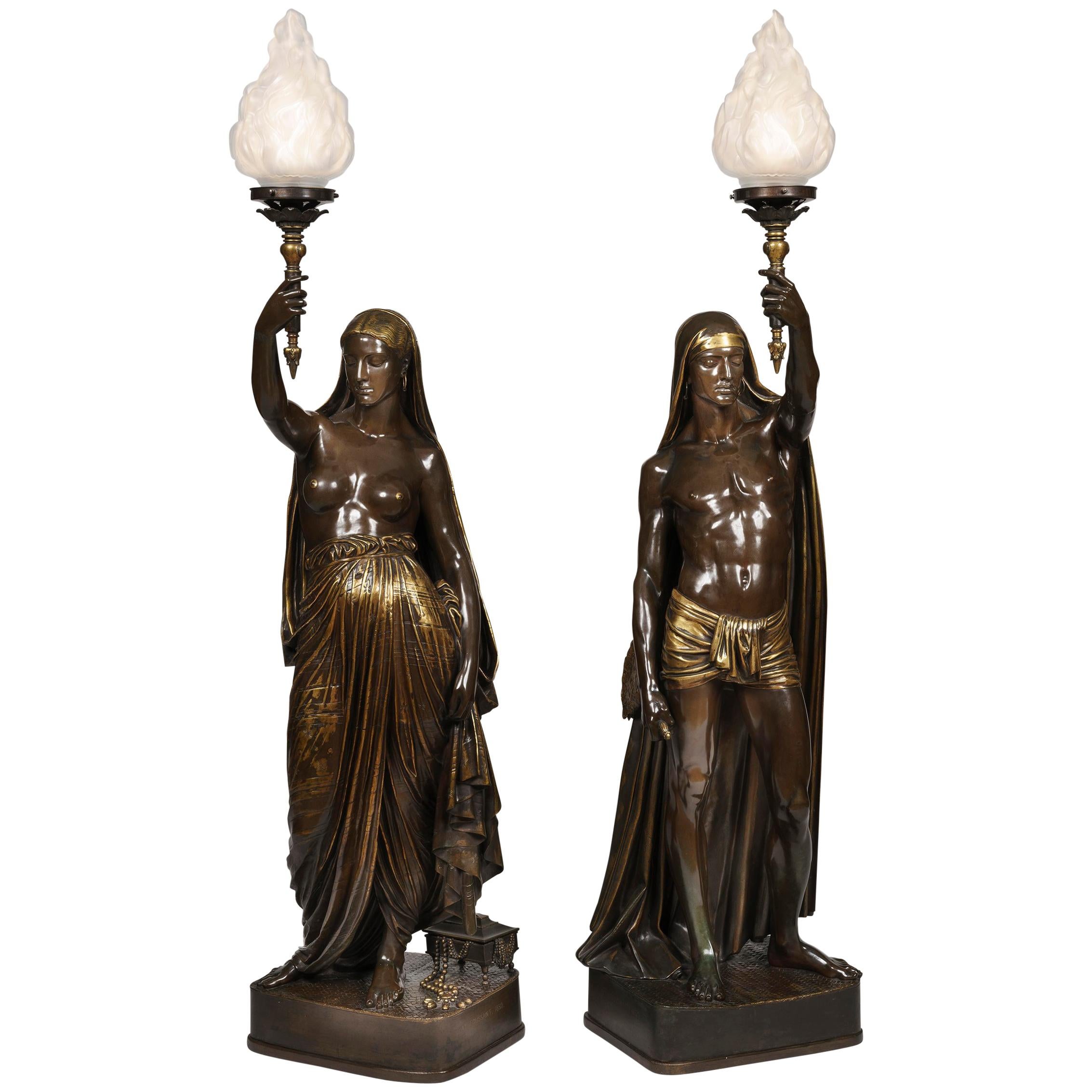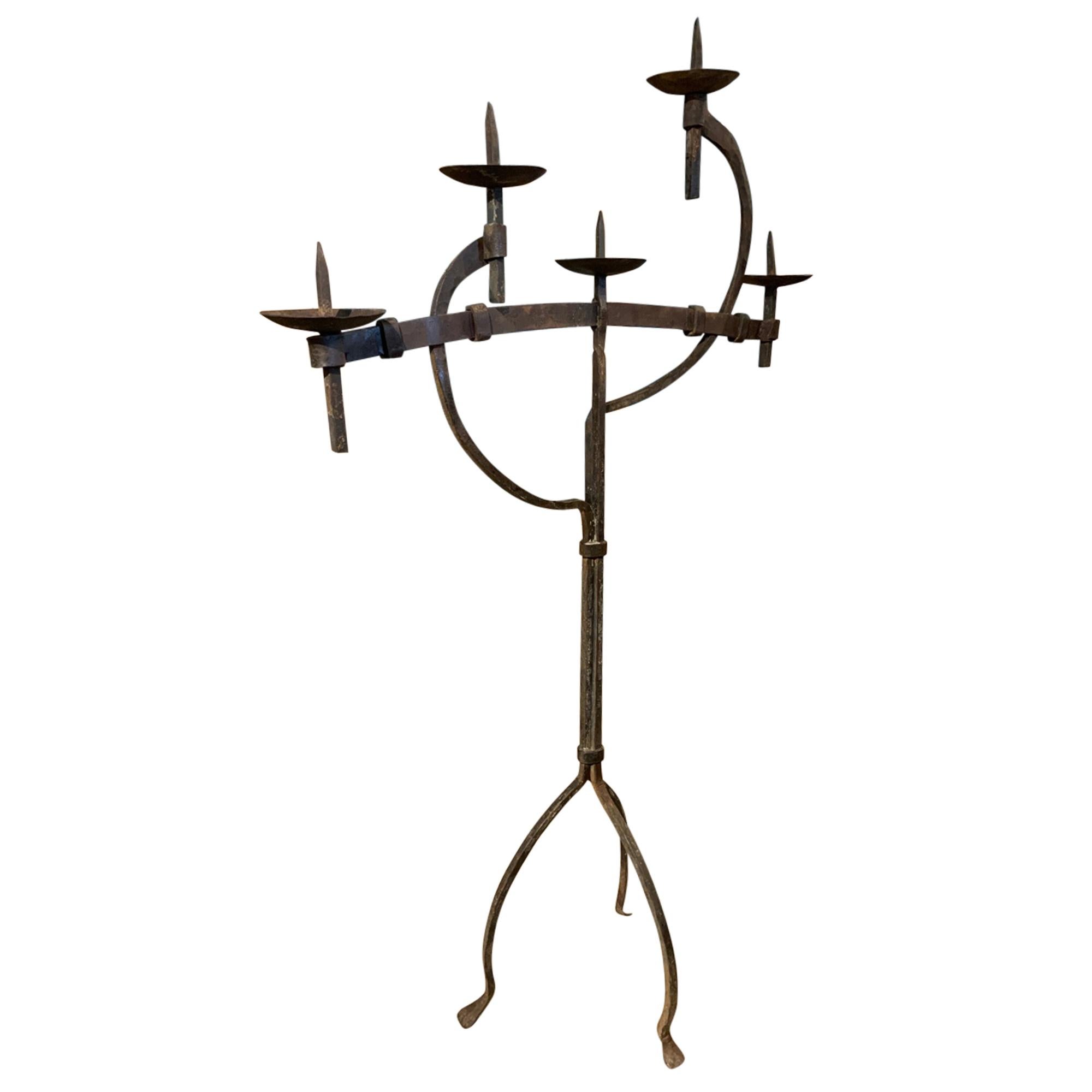Items Similar to Pair 19th Century Japanese Imari Porcelain & Gilt-Bronze Torchere Candelabra
Want more images or videos?
Request additional images or videos from the seller
1 of 21
Pair 19th Century Japanese Imari Porcelain & Gilt-Bronze Torchere Candelabra
About the Item
A fine Pair of 19th century Japanese Imari Porcelain and French Gilt-Bronze Mounted Thirteen-Light Celadon Torchere Candelabra. The bottle-shaped Japonisme vases with a Royal red background, decorated with parcel-gilt and black soaring eagles in the hunt within a forestall scene. Each Vase fitted and surmounted with a French 19th century Louis XV Style 13-Light scrolled candelabrum and all raised on a circular pierced gilt-bronze plinth. circa: 1880.
Imari Porcelain (????) is the name for Japanese porcelain wares made in the town of Arita, in the former Hizen Province, northwestern Kyushu. They were exported to Europe extensively from the port of Imari, Saga, between the second half of the 17th century and the first half of the 18th century. The Japanese as well as Europeans called them Imari. In Japanese, these porcelains are also known as Arita-yaki (???). Imari or Arita porcelain has been continously produced up through the present day.
Characteristics
Though there are many types of Imari, Westerners' conception of Imari in the popular sense is associated only with a type of Imari produced and exported in large quantity in mid-17th century. This type is called Kinrande. Kinrande Imari is colored porcelain with cobalt blue underglaze and red and gold overglaze. The color combination was not seen in China at that time. Traditional Ming dynasty color porcelain used dominantly red and green, probably due to scarcity of gold in China, whereas gold was abundant in Japan in those days. The subject matter of Imari is diverse, ranging from foliage and flowers to people, scenery and abstractions. Some Imari design structures such as kraak style were adopted from China, but most designs were uniquely Japanese owing to the rich Japanese tradition of paintings and costume design. The porcelain has a gritty texture on the bases, where it is not covered by glaze. There is also blue and white Imari. Kakiemon style Imari is another type of Imari, but it tends to be categorized separately in Europe.
History
"Imari" was simply the trans-shipment port for Arita wares. It was the kilns at Arita which formed the heart of the Japanese porcelain industry.
Arita's kilns were set up in the 17th century, when kaolin was discovered in 1616 by the immigrant Korean potter, Yi Sam-pyeong (1579–1655). (He may also be known by the name, "Kanage Sambei".) Yi Sam-Pyeong, along with his extended family of 180 persons, left Korea on the offer of a privileged position in Japan. This decision was made after the occurrence of certain Japanese invasions of Korea. After Yi Sam-Pyeong's discovery, his kilns began to produce revised Korean-style blue and white porcelains, known as "Shoki-Imari".
In the mid-17th century there were also a lot of Chinese refugees in Northern Kyushu due to the turmoil on Chinese continent, and it is said one of them brought coloring technique to Arita. Thus Shoki-Imari developed into Ko-KutaniImari. Ko-Kutani was produced around 1650 for both export and domestic market. Blue and white porcelain continued to be produced and they are called Ai-Kutani. Ko-Kutani Imari for the export market usually adopted Chinese design structure such as kraak style, whereas Ai-Kutani for the domestic market were highly unique in design and are accordingly valued very much among collectors.
Ko-Kutani style evolved into Kakiemon style Imari, which was produced for about 50 years around 1700. Imari achieved its technical and aesthetic peak in Kakiemon style, and it dominated European market. Blue and white Kakiemon is called Ai-Kakiemon. Kakiemon style transformed into Kinrande in the 18th century. Kinrande used blue underglaze and red and gold overglaze, and later some other colors.
Imari began to be exported to Europe because the Chinese kilns at Ching-te-Chen were damaged in the political chaos and the new Qing dynasty government stopped trade in 1656–1684. Exports to Europe were made through the Dutch East India Company, but the designation "Imari Porcelain" in Europe connotes Arita wares of mostly Kinrande Imari.
Export of Imari to Europe stopped in mid-18th century when China began export to Europe again, since Imari was not able to compete against China due to high labor cost. By that time, however, both Imari and Kakiemon style were already so popular among Europeans, Chinese export porcelain copied both Imari and Kakiemon style, which is called Chinese Imari. At the same time, European kilns, such as Meisen also tried to copy Imari and Kakiemon.
Export of Imari surged again in late 19th century (Meiji era) when Japonism flourished in Europe. Thus in western world today, two kinds of Imari can be found: that exported in the mid-Edo period, and that exported in the Meiji. From the viewpoint of collectors these two types are completely different, though Kinrande appearances are similar.
Nabeshima is the other category of Imari. Nabeshima is a kind of Imari produced in Lord Nabeshima's official kiln only for the official use of Lord Nabeshima throughout Edo period. As such, Nabeshima is characterized by its distinctively noble design.
In Japanese mythology has an eagle god, appearing in the "Nihon Shoki" and "Kogo Shui" as "Amenohiwashi-no-kami". Japanese ancestors felt a special respect for large birds like eagles and hawks. In Japanese culture, the eagle is a symbol of the great power of nature that has existed since ancient times.
Measures: Overall Height (to top of light bulb): 72 1/4 inches (183.5 cm)
Top of candelabra height: 64 1/4 inches (163.2 cm)
Diameter: 24 1/4 inches (61.6 cm)
Gilt-Bronze Base: 14 inches by 14 inches (35.6 cm by 35.6 cm).
- Attributed to:Imari Porcelain (Maker)
- Dimensions:Height: 72.25 in (183.52 cm)Diameter: 24.25 in (61.6 cm)
- Sold As:Set of 2
- Power Source:Plug-in
- Voltage:110-150v
- Lampshade:Not Included
- Style:Japonisme (In the Style Of)
- Materials and Techniques:
- Place of Origin:
- Period:
- Date of Manufacture:circa 1880
- Condition:Additions or alterations made to the original: Electrified. Some old nicks, scratches, rubbing, wear and age discoloration to the porcelain vases as expected for their age and use. The gilt-bronze candelabra has had some minor restorations. Please view all images. Wear consistent with age and use. Minor losses. Minor fading. A truly beautiful and very impressive pair of torchere lamps. Overall condition is good with some age wear, scratches, slight discoloration and other as noted above. Finely decorated with fine attention to detail. Please view all images.
- Seller Location:Los Angeles, CA
- Reference Number:
About the Seller
5.0
Vetted Seller
These experienced sellers undergo a comprehensive evaluation by our team of in-house experts.
Established in 1982
1stDibs seller since 2016
114 sales on 1stDibs
Typical response time: <1 hour
- ShippingRetrieving quote...Ships From: Los Angeles, CA
- Return PolicyThis item cannot be returned.
More From This SellerView All
- Pair of French Belle Époque 19th-20th Century Gilt Bronze and Alabaster TorchereLocated in Los Angeles, CAA palatial pair of French Belle Époque 19th-20th century gilt bronze and alabaster tall torchières. The slender center column raised on a circular intri...Category
Antique Early 1900s French Belle Époque Floor Lamps
MaterialsAlabaster, Bronze
- Fine French 19th-20th Century Louis XV Style Belle Epoque Gilt-Bronze TorchereLocated in Los Angeles, CAA fine and Large French 19th-20th century Louis XV Style Belle Époque gilt bronze four-light torchère with Laurel Wreaths with white opaline glass globes, raised on a two-tone circul...Category
Antique Early 1900s French Louis XV Floor Lamps
MaterialsMarble, Bronze
- Pair French 19th-20th Century Neoclassical Style Iron and Parcel-Gilt TorcheresLocated in Los Angeles, CAA Palatial Pair of French 19th/20th Century Neoclassical Revival Style Ebonized Cast-Iron and Parcel-Gilt Torcheres (torchières - Lamp Posts). The park-like torcheres surmounted with...Category
Antique Early 1900s French Neoclassical Revival Floor Lamps
MaterialsIron, Zinc
- An Italian 19th Century Patinated Bronze Torchere, After Niccolò RoccatagliataBy Niccolo RoccatagliataLocated in Los Angeles, CAA Large and Impressive Italian 19th Century Patinated Bronze Figural Torchere, after a model by Niccolò Roccatagliata (Genoa 1593 - Venice 1636). The triangular foot base with projecting putti supporting the stem and oval reserves within cartouche motifs, one containing the initials "S.D" with an olive tree in-between and a bull-head below. The stem knot with figures of winged caryatids and festoons and upper part with cherub heads, acanthus leaves and egg and bead patterns and topped with a later white glass globe. The decorative system refers to the documented artistic production of the Venetian workshop of Niccolò Roccatagliata and takes inspirational model from the base of the Renaissance bronze of the Scuola Grande di San Teodoro in Venice, a work signed by Andrea del Bartolomeo di Alessandri known as Brescianino. Electrified. Circa: Venice, 1850-1880. RELATED LITERATURE L. Planiscig, Venezianische Bildhauer der Renaissance, Vienna, 1921, figs. 661-664; C. Avery, 'Andrea del Bartolomeo di Alessandri detto il Bresciano" lavator di gettar di Bronzo": candelabri, satiri e battenti', M. Ceriana and V. Avery (eds.), L'Industria artistica del Bronzo del Rinascimento a venezia e nell'Italia settentrionale, Venice, 2008, pp. 233-252. Similar models of this torchere were part of the interior decor collection at the Vanderbilt Mansion in New York (see black and white photo). The Cornelius Vanderbilt II House was a large mansion built in 1883 at 1 West 57th Street in Manhattan, New York City. It occupied the frontage along the west side of Fifth Avenue from West 57th Street up to West 58th Street at Grand Army...Category
Antique 19th Century Italian Baroque Floor Lamps
MaterialsBronze
- Pompeiian Style 19th-20th Century Bronze Tripod Torchere, Attr. E.F. CaldwellBy Edward F. Caldwell & Co.Located in Los Angeles, CAA Rare Tall Pompeiian Style 19th-20th century gilt patinated bronze tripod torchere Floor Lamp fitted with a molded glass shade. The tall fluted center column, topped with decorated ...Category
Antique Early 1900s American Empire Revival Floor Lamps
MaterialsBronze
- Pair of 19th Century Gilt-Bronze & Faience Porcelain Table Lamp CandelabrasLocated in Los Angeles, CAA fine pair of French 19th-20th century Louis XV style gilt bronze and Faience porcelain three-light candelabra table lamps. The ovoid porcelain urn hand decorated in floral burgundy...Category
Antique Early 1900s French Louis XV Table Lamps
MaterialsOrmolu, Bronze
You May Also Like
- Large 19th Century Pair of Bronze Figural TorcheresBy A. Toussaint - G. Chaudoir, Ferdinand BarbedienneLocated in London, GBA pair of Figural Porte-Lumières, cast by Barbedienne from the celebrated Armand Toussaint Models Constructed in bronze, and having a patinated natural, and a highlighted gilt patin...Category
Antique Mid-19th Century French Romantic Floor Lamps
MaterialsBronze
- Pair of 19th Century Carved Giltwood Torchères with Crystal CandelabraLocated in London, GBA Pair of Giltwood Carved Torchères After the Design by Jean Pelletier for the King's State Apartments Supported on incurved tripartite plinths, the pair of torchères hand-carved i...Category
Antique 19th Century English Baroque Revival Floor Lamps
MaterialsCrystal, Ormolu
- Late 19th Century Gilt Bronze and Japanese Satsuma Porcelain Floor LampBy SatsumaLocated in New York, NYLate 19th Century Gilt Bronze and Japanese Satsuma Porcelain Floor Lamp The round lamp with painted scenes of men, women and children in landscape scenes and at leisure...Category
Antique Late 19th Century Japanese Belle Époque Floor Lamps
MaterialsBronze
- Large Classical 19th Century Bronze CandelabraLocated in Brighton, SussexA wonderfully impressive 19th Century classical French Bronze near life size semi clad statue of a maiden with grape and vine leaf headress, holding a loft an eight branch gilded ormolu candelabra, with a central urn. Raised on a green and white veined and fluted marble pedestal...Category
Antique 19th Century French Classical Greek Floor Lamps
MaterialsMarble, Bronze
- French 19th Century TorchèreLocated in Atlanta, GAA very intriguing later 19th century French torchère - Standing candelabra - in expertly hand forged iron. A beautiful art piece.Category
Antique 19th Century French Floor Lamps
MaterialsIron
- 19th Century Pair of Imari Porcelaine Lamp Mounted Gilt BronzeBy Imari PorcelainLocated in Marseille, FR19th century pair of porcelain lamp from Imari. Frame gilt bronze decorations of metal polychrome flowers.Category
Antique 19th Century Chinese Chinese Export Ceramics
MaterialsPorcelain
Recently Viewed
View AllMore Ways To Browse
Porcelain Gilt
Porcelain With Bronze
Porcelain Lamps Pair
Pair Porcelain Lamp
Antique Porcelain Lighting
Used Kiln Furniture
Antique Lamps Porcelain
Antique Porcelain Lamp Lamps
Antique Lamp Porcelain
Antique Porcelain Lamps Lamps
Lamps Porcelain White
Porcelain Lamp Base
Porcelain Gilt Base
Japanese Porcelain By
Antique Kilns
Lamps With Porcelain Base
Mid Century Porcelain Lamp
Chinese Porcelain Lamp Porcelain





